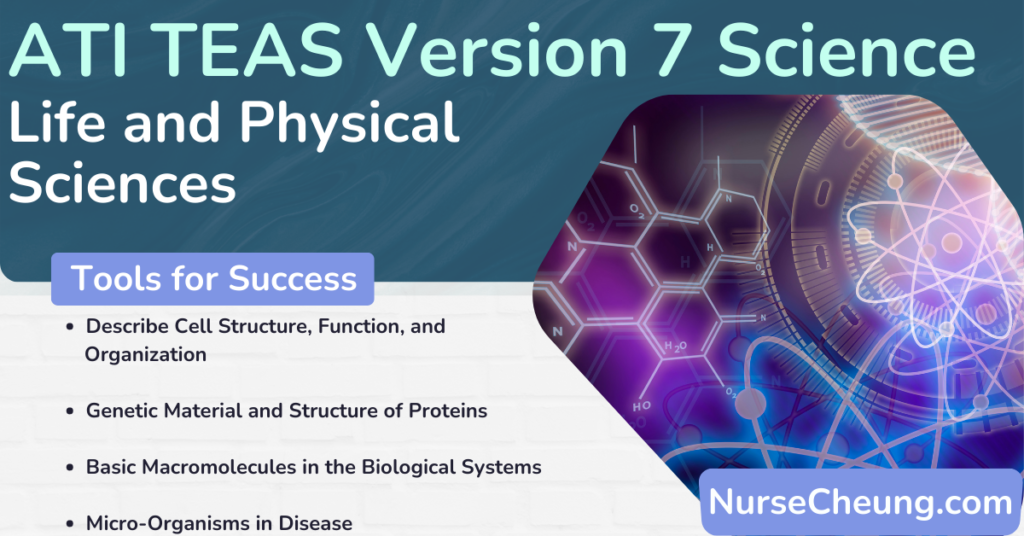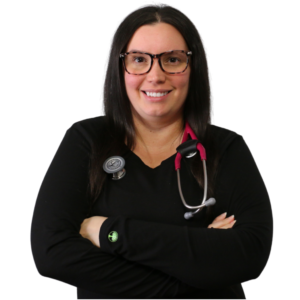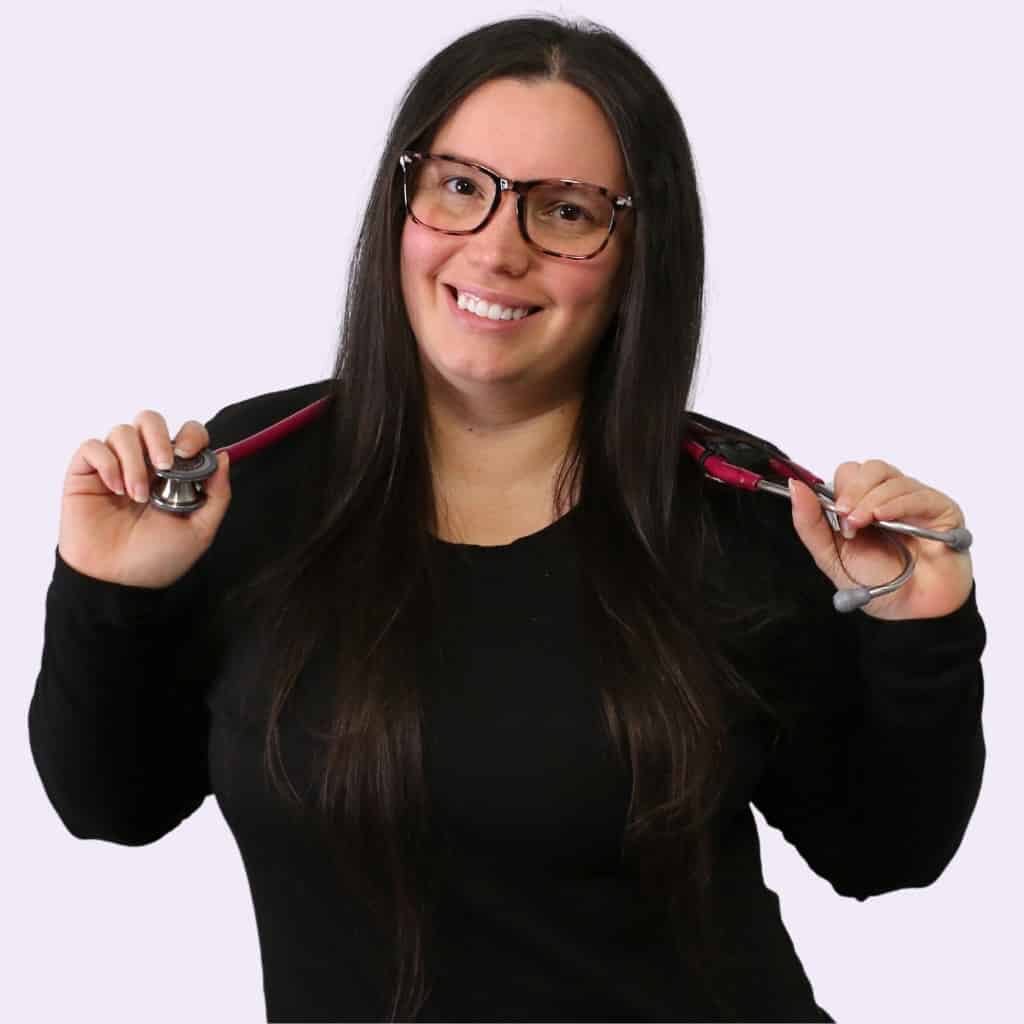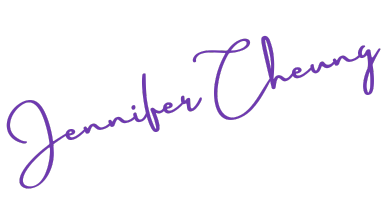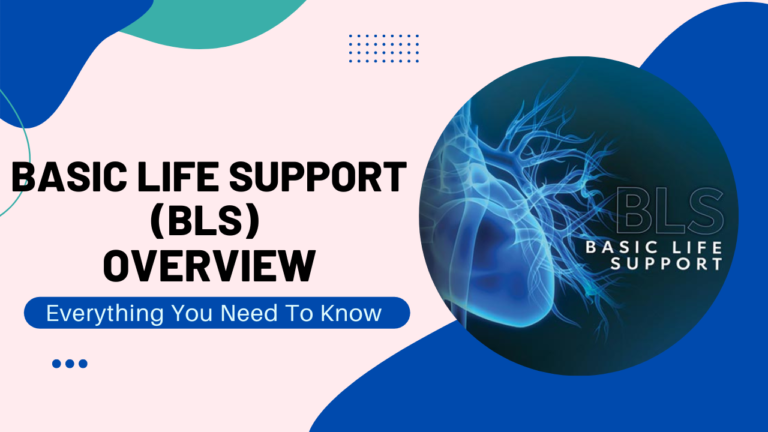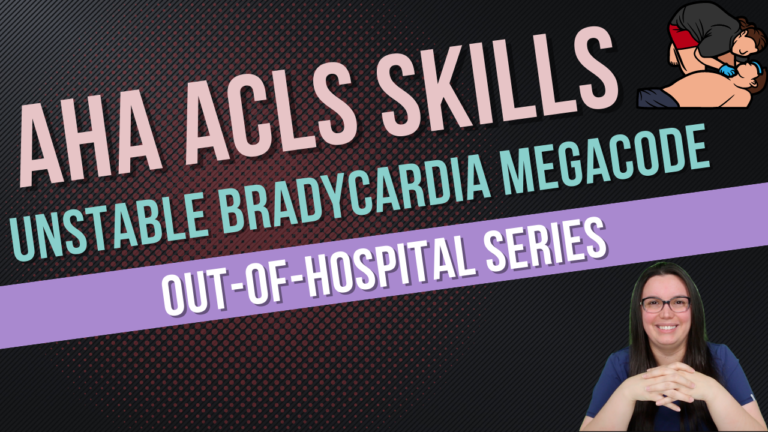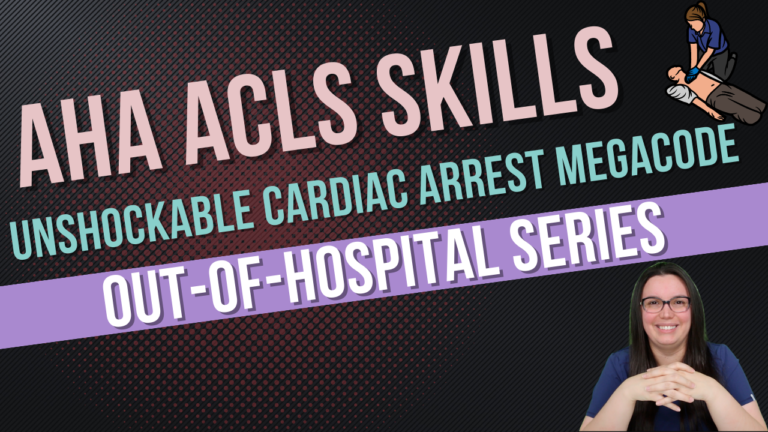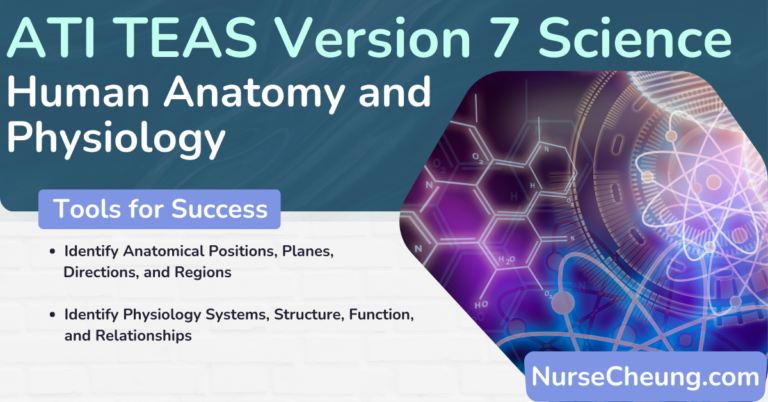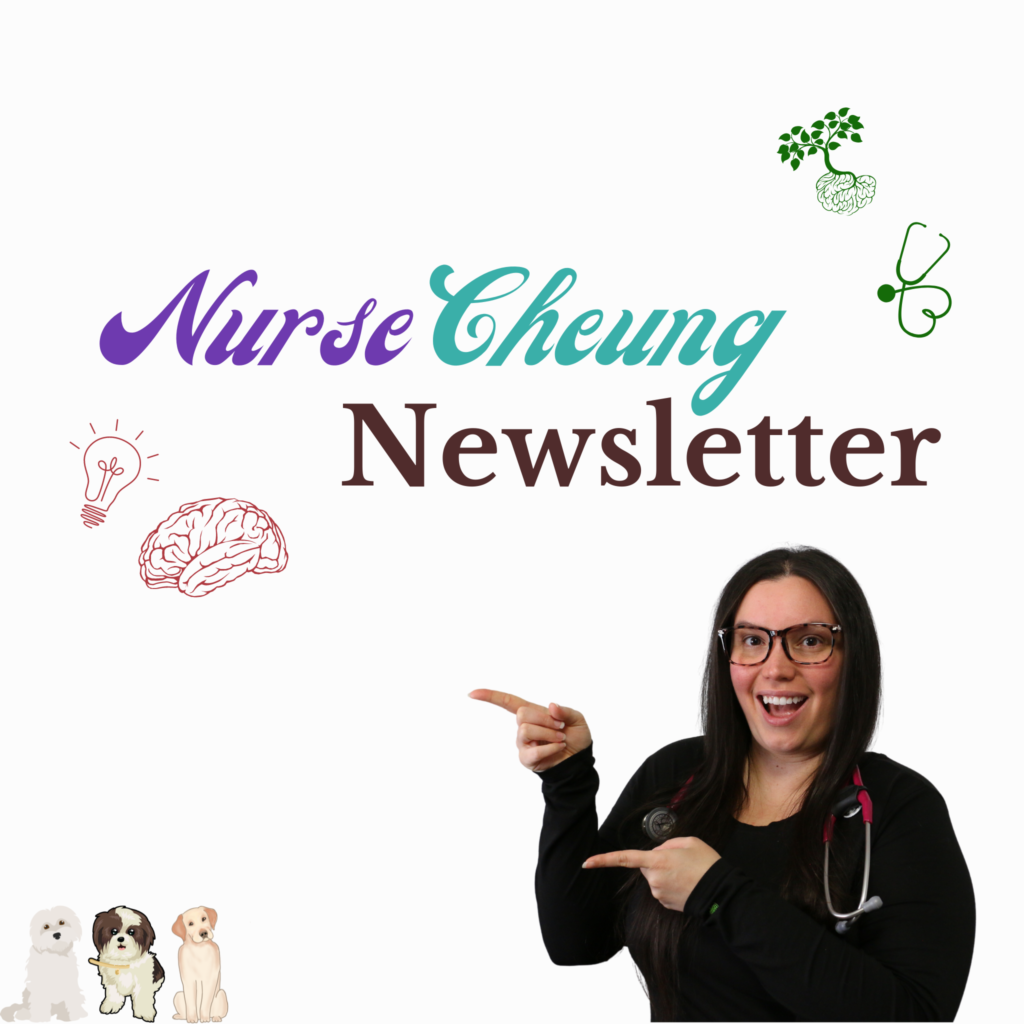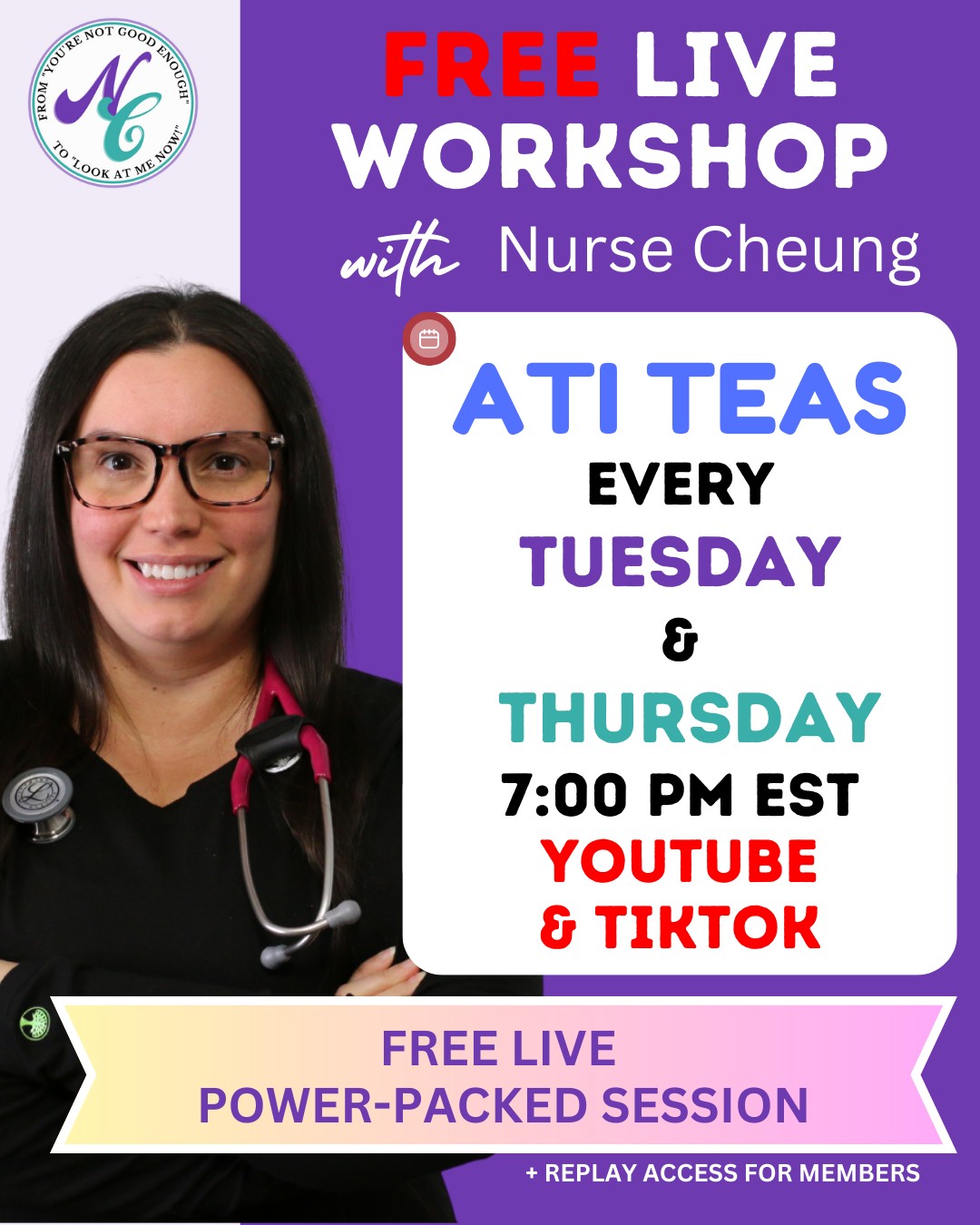Are you preparing to take the ATI TEAS Science Test?
If so, you will want to read this in-depth guide! We will provide an overview of the topics covered on the test, as well as some tips and strategies for success.
In this article, we will focus on the Life Sciences section.
Objectives for Life and Physical Science
Total scored items on ATI TEAS: 9 questions out of 44
Describe Cell Structure, Function, and Organization
Biological Hierarchy of the Body
When we discuss biological hierarchy, we are discussing the way we organize structures in living things by classifying structures from basic components to more complex components.
These structures are broken down into the following categories: chemicals, cells, tissues, organs, organ systems, and organisms.
Chemicals help build cells. Macromolecules are chemicals that are essential to life and are important in carbohydrates, proteins, lipids, and nucleic acids.
The cell is the basic unit of life. All living things are made up of cells. Cells perform all the functions necessary for life. There are more than 250 different types of cells that help the human body carry out life processes.
Tissues are made up of cells that have a similar structure and function. There are four types of tissues in the human body: epithelial, connective, muscle, and nervous. Tissues can help carry out functions such as protection, support, movement, and communication.
For example, the lungs deliver oxygen to the tissues via the bloodstream.
Organs are made up of tissues that work together to carry out a specific function. For example, the heart pumps blood through the body.
Organ systems are a group of organs that work together to carry out a specific function. The human body has 11 organ systems: the integumentary, skeletal, muscular, nervous, endocrine, cardiovascular, lymphatic, respiratory, digestive, urinary, and reproductive.
Each organ system has a specific function that helps the body carry out life processes. For example, the integumentary system helps protect the body from disease and infection.
Organisms are made up of one or more organ systems. Humans are multicellular organisms that are made up of 11 organ systems previously discussed.
Cell Structure and Function
Cells are the basic unit of life. All living things are made up of cells. Cells perform all the functions necessary for life. There are more than 250 different types of cells that help the human body carry out life processes.
The cell is composed of ten parts: the cell membrane, cytoplasm, Golgi Apparatus, lysosome, mitochondrion, nucleus, ribosomes, rough endoplasmic reticulum, smooth endoplasmic reticulum, and vacuole.
- The cell membrane is a thin layer of protein and fat that surrounds the cell. The cell membrane is selectively permeable, meaning that it allows some substances to enter and exit the cell while keeping other substances out.
- The cytoplasm is a jelly-like substance that contains the cell’s organelles. It helps support and suspends the structures inside the cell membrane. It can also transfer material required for other cellular processes.
- The Golgi Apparatus is an organelle that helps to package and transport molecules within the cell. it also helps process proteins and lipid molecules.
- Lysosomes are organelles that contain enzymes that break down food and other molecules. They aid in digestion and recycle old cell materials. Lastly, they destroy invading bacteria and viruses.
- Mitochondria are organelles that produce energy for the cell. They convert nutrients into ATP, which is the cell’s energy source.
- The nucleus is an organelle that contains the cell’s hereditary information also known as DNA. DNA is responsible for the cell’s growth, reproduction, and function.
- Ribosomes are organelles that help synthesize proteins. Proteins are essential for the cell to carry out its functions. These organelles can be round on either the rough-endoplasmic reticulum or floating in the cytoplasm.
- The rough endoplasmic reticulum is an organelle that helps to package and transport molecules within the cell. It is also involved in the synthesis of proteins.
- The smooth endoplasmic reticulum is an organelle that helps to package and transport molecules specifically lipids within the cell but does not contain ribosomes. It is also involved in carbohydrate metabolism and inactivates toxins along with harmful metabolic products.
- A vacuole is an organelle that stores food, water, and other materials. It also helps to maintain the cell’s shape.
Mitosis Process of the Cell Cycle
Mitosis is the process of cell division that results in two genetically identical daughter cells. The cell cycle is the sequence of events that a cell goes through as it grows and divides.
The cell cycle has four main stages: interphase, prophase, metaphase, anaphase, and telophase.
- Interphase is the first stage of the cell cycle. It is when the cell grows and carries out its normal functions. DNA starts to replicate.
- Prophase is the second stage of the cell cycle. In this stage, the chromosomes condense and become visible. The nuclear envelope also breaks down.
- Metaphase is the third stage of the cell cycle. In this stage, the chromosomes line up in the middle of the cell.
- Anaphase is the fourth stage of the cell cycle. In this stage, the chromosomes are pulled apart to opposite sides of the cell. Cell division begins.
- Telophase is the fifth and final stage of the cell cycle. In this stage, a new nuclear envelope forms around the chromosomes. The chromosomes uncoil and become less visible. The cell then divides into two daughter cells.
The cell cycle is a continuous process that takes place in all cells. Mitosis is just one part of the cell cycle. After telophase, the two daughter cells enter interphase and the cell cycle starts all over again.
Meiosis Process of the Cell Cycle
Cells can also divide through a process called meiosis. Meiosis is a type of cell division that results in four genetically diverse daughter cells.
Unlike mitosis, meiosis also has two main stages: meiosis I (interphase, prophase I, metaphase I, anaphase I, telophase I), and meiosis II (prophase II, metaphase II, anaphase II, and telophase II).
Interphase is the first stage of meiosis. The cell grows and carries out its normal functions. DNA starts to replicate.
Meiosis I
Prophase I is the second stage of meiosis. In this stage, the homologous chromosomes pair and start to crossover.
Metaphase I is the third stage of meiosis. In this stage, the homologous chromosomes line up in the middle of the cell in pairs.
Anaphase I is the fourth stage of meiosis. In this stage, the one chromosome from each homologous pair is pulled apart to opposite sides of the cell.
Telophase I is the fifth stage of meiosis. In this stage, the two daughter cells start to form. Each cell has half the number of chromosomes as the original cell. The cells also have a mixture of genetic information.
Meiosis II
Prophase II is the sixth stage of meiosis. In this stage, the daughter cells contain half of the chromosomes from the original cells.
Metaphase II is the seventh stage of meiosis. In this stage, the chromosomes line up in the middle of the cell again.
Anaphase II is the eighth stage of meiosis. In this stage, the sister chromatids are pulled apart to opposite sides of the cell.
Telophase II is the ninth and final stage of meiosis. In this stage, the cells divide into four genetically diverse daughter cells also known as haploids.
Meiosis is a continuous process that takes place in all cells. Meiosis I and II are just two parts of meiosis.
Describe the Relationship between Genetic Material and the Structure of Proteins
Chromosomes
Chromosomes are long, thread-like structures that are found in the nucleus of cells. They are made up of DNA and histone proteins. The winding structure condenses DNA and allows regulation.
All species of living things have chromosomes. Prokaryote organisms like bacteria have one chromosome. Eukaryote organisms have multiple chromosomes.
For example, humans have 46 chromosomes in every cell of their body, except for gametes or sex cells. Whereas dogs have 78 chromosomes.
Humans have 23 pairs of chromosomes. One pair is inherited from the mother and the other pair is inherited from the father. This makes up the diploid number.
Genes
Genes are the basic units of heredity. They are made up of DNA and are responsible for the characteristics of an organism. Genes are passed down from parent to offspring.
Each gene has the instructions for making a specific protein. Proteins are large molecules that perform many functions in the body.
It is estimated that the human body has 25,000 genes.
There are two types of genes: structural and regulatory genes.
- Structural genes are responsible for the physical traits of an organism. For example, the color of your eyes or hair is determined by structural genes.
- Regulatory genes control the activity of other genes. For example, regulatory genes can turn other genes on or off.
Deoxyribonucleic Acid (DNA)
DNA is the genetic material that contains genes that are coded with instructions to produce proteins in the cell. DNA is made up of two long chains of nucleotides that twist to create a double helix.
The sequence of the nucleotides in DNA determines the order of amino acids in proteins. This is known as the genetic code. These nucleotides have four bases: A (adenine), T (thymine), G (guanine), and C (cytosine).
A base pair is two nucleotides that are bonded together. For example, A pairs with T and G pairs with C. These complementary bases are liked by hydrogen bonds pair up to hold the two strands of DNA together.
The double helix structure of DNA is very important because it allows for replication. Replication is the process of making an identical copy of DNA.
A codon is a sequence of three nucleotides that code for a specific amino acid. There are 64 possible codons in the DNA code. 61 of these codons code for amino acids and the other three “stop signal” codons will end the gene.
A mutation may occur during replication that causes a permanent change in the DNA sequence. This can result in a change in the amino acid sequence of proteins and may lead to changes in the structure or function of the protein.
Ribonucleic Acids (RNA)
RNA’s principal role is to translate the genetic code of DNA into proteins.
RNA is very similar to DNA except for a few key differences. The most notable difference is that RNA is single-stranded. RNA also has the base uracil (U) instead of thymine (T).
Transcription and Translation
Transcription is the process of making RNA from DNA. The DNA double helix unwinds and one strand of the DNA serves as a template for RNA synthesis.
RNA polymerase is an enzyme that catalyzes the formation of RNA from nucleotides. This enzyme attaches to one end of the DNA template and then moves along the template, adding nucleotides one at a time.
As RNA is being made, it is complementary to the template strand of DNA. When RNA synthesis is complete, the RNA molecule is released from the DNA template, and the DNA double helix reforms.
RNA is found in three main forms: messenger RNA (mRNA), transfer RNA (tRNA), and ribosomal RNA (rRNA).
- Messenger RNA (mRNA) is the RNA that carries the genetic code from the DNA in the nucleus to the ribosomes in the cytoplasm.
- Transfer RNA (tRNA) is the RNA that helps to assemble amino acids into proteins that act as adapters in the translation of the genetic sequence.
- Ribosomal RNA (rRNA) is the RNA that makes up ribosomes.
Translation is the process of making proteins from RNA. This occurs on ribosomes in the cytoplasm.
mRNA attaches to the small subunit of a ribosome and then tRNA brings amino acids to the ribosome. As the amino acids are brought to the ribosome, they are joined together by peptide bonds to form a protein.
The genetic code is read in groups of three nucleotides, called codons. Each codon codes for a specific amino acid.
The sequence of codons in mRNA determines the sequence of amino acids in a protein.
Apply Concepts Underlying
Mendel's Law of Inheritance
Dominant and Recessive Traits
Inheritance is the process by which traits are passed from parents to their offspring.
Mendel’s law of inheritance states that there are two alleles for each trait. Alleles are alternative forms of a gene.
One allele is dominant and the other allele is recessive. The allele that is expressed in the phenotype is the dominant allele.
Inheritance of Gene Paris
Each parent contributes one allele to their offspring. For example, if a mother has the allele for blue eyes (b) and the father has the allele for brown eyes (B), then their offspring will have the allele for blue eyes (b) and the allele for brown eyes (B).
The allele for blue eyes is recessive and the allele for brown eyes is dominant. This means that the phenotype of the offspring will be brown eyes.
However, if both parents have the allele for blue eyes (bb), then their offspring will also have the allele for blue eyes (bb) and the phenotype of the offspring will be blue eyes.
The combination of two alleles is called a genotype. If the chromosome contains two different alleles for a trait, then the genotype is heterozygous. If the chromosome contains two identical alleles for a trait, then the genotype is homozygous.
In the example above, the mother’s genotype is heterozygous (Bb) and the father’s genotype is heterozygous (Bb). The offspring’s genotype has a 25% chance of being homozygous (bb).
Using Punnett Squares
A Punnett square is a tool that is used to predict the genotypes and phenotypes of offspring.
To use a Punnett square, you need to know the genotypes of the parents.
In the Punnett square above, the mother’s genotype is represented by the letters “B” and “b” and the father’s genotype is represented by the letters “B” and “b”.
The genotypes of the offspring are represented by the letters “B” and “b”.
The phenotype of the offspring is represented by the color of the eyes.
As you can see, there is a 25% chance that the offspring will have blue eyes and a 75% chance that the offspring will have brown eyes.
Inheritance of Multiple Alleles or Dihybrid Cross
There are two alleles for each trait. However, there are more than two alleles for some traits.
For example, the allele for hair color can be black (B), brown (b), or blond (bl).
The allele for eye color can be blue (r), brown (R), or green (G).
A dihybrid cross is a Punnett square that shows the inheritance of two traits.
In the Punnett square above, the father’s genotype is represented by the letters “B”, “b”, and “bl” and the mother’s genotype is represented by the letters “B”, “b”, and “G”.
The genotypes of the offspring are represented by the letters “B”, “b”, “bl”, and “G”.
The phenotype of the offspring is represented by the color of the eyes and the color of the hair.
As you can see, there is a 25% chance that the offspring will have black hair and blue eyes, a 25% chance that the offspring will have black hair and brown eyes, a 25% chance that the offspring will have blond hair and blue eyes, and a 25% chance that the offspring will have blond hair and green eyes.
Non-Mendelian Inheritance
There are some exceptions to Mendel’s law of inheritance.
One example of non-Mendelian inheritance is incomplete dominance. In incomplete dominance, the phenotype of the offspring is a blend of the phenotypes of the parents.
For example, if a red flower (RR) is crossed with a white flower (WW), the offspring will be pink (RW).
Another example of non-Mendelian inheritance is codominance. In codominance, the phenotype of the offspring is a combination of the phenotypes of the parents.
For example, if a black chicken (BB) is crossed with a white chicken (WW), the offspring will be black and white (BW).
There are also some exceptions to Mendel’s law of independent assortment.
One example of this is linkage. Linkage is when two genes are located close to each other on the same chromosome and are inherited together.
Another example of this is sex-linked inheritance. Sex-linked inheritance is when a gene is located on the X or Y chromosome.
The most common example of this is color-blindness, which is caused by a gene located on the X chromosome.
Describe Structure and Function of Basic Macromolecules in the Biological System
Macromolecules
Macromolecules are large molecules that are essential for the structure and function of cells.
A polymer is a macromolecule that is made up of smaller units called covalent bond-linked monomers.
Chemical reactions can occur known as dehydration and hydrolysis.
- Dehydration synthesis is the formation of larger molecules from smaller reactants accompanied by the loss of a water molecule.
- Hydrolysis is the process of breaking down bonds to break monomers.
There are four major types of macromolecules: carbohydrates, lipids, proteins, and nucleic acids.
Carbohydrates
Carbohydrates are composed of carbon, hydrogen, and oxygen. They are also known as “sugars” or “starches” found in all living organisms.
They can be monosaccharides, disaccharides, or polysaccharides.
- Monosaccharides are the simplest type of carbohydrate and they cannot be hydrolyzed to produce smaller units. A common monosaccharide is glucose.
- Disaccharides are two monosaccharides that are joined by a covalent bond. A common disaccharide is sucrose (table sugar).
- Polysaccharides are long chains of monosaccharides that are joined by covalent bonds. A common polysaccharide is starch and cellulose.
Carbohydrates can also take many different forms to perform functions. These forms can be linear, branched, and helix-shaped.
- Linear carbohydrates are long unbranched chains of monosaccharides that form structures. For example, cellulose is a major component of rigid cell walls in plants.
- Branched carbohydrates are shorter chains of monosaccharides with branches. For example, maltose is a common disaccharide found in germinating seeds that are used for energy storage.
- Helix-shaped carbohydrates are coiled chains of monosaccharides that form structures. For example, DNA is a double helix-shaped nucleic acid.
Lipids
Lipids are composed of carbon, hydrogen, and oxygen. They are important energy storage, structural, and hormone macromolecules. Lipids are formed by a linear arrangement of carbon atoms and hydron atoms called fatty acid chains.
Lipids tend to be hydrophobic and nonpolar meaning they do not mix well with water.
Lipids can be divided into four groups: fat and oils, waxes, phospholipids, and steroids. All of these groups are insoluble in water.
- A fat molecule is composed of a glycerol molecule and three fatty acid chains. Fats are used for long-term energy storage in the body. They are also useful in cushioning and insulating the human body.
- Waxes are composed of a long chain of fatty acids that are linked to long-chain alcohol. Waxes serve as a protective coating on the surface of plants.
- Phospholipids are composed of a glycerol molecule, two fatty acid chains, and a phosphate group. Phospholipids are a major component of cell membranes.
- Steroids are composed of four interconnected carbon rings. Steroids include cholesterol, which is a structural component of cell membranes, and hormones like testosterone and estrogen. They are often used as chemical messengers.
Proteins
Proteins are composed of carbon, hydrogen, oxygen, nitrogen, and sometimes sulfur. Proteins are made up of smaller units called amino acids that are linked together by peptide bonds.
Proteins can be classified into four groups: enzymes, structural proteins, storage proteins, and transport proteins.
- Enzymes are proteins that catalyze biochemical reactions without being consumed by the reaction. They speed up reactions by lowering the energy required to initiate the reaction. These reactions can be exergonic (release energy) or endogenic (require energy).
- Structural proteins provide support and structure.
- Storage proteins store nutrients.
- Transport proteins transport molecules.
Nucleic Acids
Nucleic acids are composed of carbon, hydrogen, oxygen, nitrogen, and phosphorus. Nucleic acids store and transmit genetic information.
There are two types of nucleic acids: deoxyribonucleic acid (DNA) and ribonucleic acid (RNA) as we discussed previously.
Describe the Role of Micro-Organisms in Disease
Micro-Organisms
Micro-organisms, also known as microbes, are tiny living organisms. They are too small to be seen with the naked eye and can only be seen with a microscope.
Micro-organisms are found everywhere, including in the air, soil, water, and on plants and animals. Some micro-organisms can cause disease. Others are used in the production of food and drugs, or to help with the decomposition of organic matter.
The human body is home to many different types of micro-organisms, including bacteria, viruses, protozoans, fungi, and animals. Most of these micro-organisms are harmless and even helpful. For example, the bacteria in our gut help us to digest food.
However, some micro-organisms can cause disease. This can happen when they enter our bodies and multiply. It can also happen when the micro-organisms produce toxins that make us sick.
- Bacteria are single-celled micro-organisms that can live in many different environments. Some bacteria cause diseases such as tuberculosis, meningitis, food poisoning, and more. Bacterial cells lack a nucleus making them prokaryotic in nature. Not all bacteria are pathogenic as many are harmless and help with body functions
- Viruses are even smaller than bacteria and can only be seen with an electron microscope. They are not considered to be alive because they cannot reproduce on their own. Viruses must infect a host cell in order to reproduce. Examples include influenza, COVID-19, measles, mumps, and HIV.
- Protozoans are single-celled micro-organisms that are found in water, soil, and air. They feed on other cells and divide based on their mode of movement (flagellar, ciliary, and amoeboid). Some protozoans cause diseases such as malaria, giardiasis, and amoebic dysentery.
- Fungi are micro-organisms that are classified as eukaryotes (cells with a nucleus). They can be found in air, soil, water, and on plant and animal bodies. Some fungi are helpful, such as those used in the production of bread, cheese, and beer. Other fungi can cause diseases such as athlete’s foot, ringworm, and candidiasis.
- Animals such as parasitic worms are large enough for people to see with the naked eye and can live on the body. Flatworms can live in the intestines and roundworms can live in the GI and lymphatic systems.
Infectious vs Non-Infectious Diseases
Infectious diseases can be spread from one person to another such as bacteria, viruses, protozoa, and fungi. They are commonly known as communicable diseases. Some examples include chickenpox, COVID-19, and cholera.
Noninfectious diseases are not caused by microorganisms and cannot be spread from person to person. They include cancer, heart disease, and diabetes.
How do Infectious Diseases Spread
Infectious diseases can spread through direct contact, indirect contact, or vectors.
- Direct contact is when the infectious agent comes into contact with the mucous membranes or broken skin of another person. This can happen through shaking hands then touching your mucous membranes, kissing and broken skin present, or sexual contact.
- Indirect contact is when an infectious agent comes into contact with an object or surface that another person will then touch. An example of this would be touching a doorknob that someone with the flu touched.
- Vectors are living organisms that can carry and transmit an infectious agent to humans or other animals. The most common vectors are mosquitoes, ticks, and fleas.
Microscopes
A microscope is an instrument used to enlarge objects so they can be seen more clearly. There are two main types of microscopes used by microbiologists: light and electron microscopes.
Light microscopes are dependent on a light source. There are several types of light microscopes including dark-field, bright-field, phase contrast, fluorescence, differential interference contrast, and confocal scanning laser microscopes.
Electron microscopes are dependent on an electron beam. They are used to seeing objects at a much higher magnification than light microscopes (put to 150,000 times the size of the specimen). There are two types of electron microscopes: transmission (TEM) and scanning (SEM).


